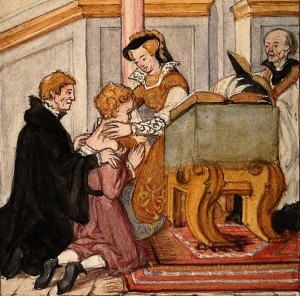Peer Reviewed
It was around the 300s BCE when a sow must have had her snout near Mycobacterium intercellularae, an environmental saphrophyte that lives in soil and water. After some time, she—like many of her community—developed tubercles in her cervical lymph nodes. Aristotle noted that this happened to many domesticated animals such as pigs and oxen. Though this phenomenon was likely noted by many of the time, Aristotle’s is the first written record of it. Some time later, a physician noticed a child with similar nodes on his neck, lovingly recalled Aristotle’s pig, and called the condition scrofula, the dimunitive form of scrofa, Latin for “breeding sow”. Though the original description of the disease is Greek, the word was first found in medical literature in Latin Italian texts either fifteenth or sixteenth centuries, as sources vary.
Scrofula can be traced through human history. Readers of Shakespeare may recall in Macbeth, Act IV, Scene 3, a doctor enters. Malcolm comments that subjects come, “all swoln and ulcerous” (afflicted with scrofula no doubt), and are cured by the King’s “hanging a golden stamp about their necks, / Put on with holy prayers”; a reflection of the belief that this disease, then known as the King’s evil, could be cured by the Royal Touch.
For years, physicians reeled with whether scrofula, consumption, and phthisis might be related tubercular diseases. In an 1842 issue of the Lancet [1], Dr. W. Wilson—the physician to the West London Institute for Diseases of the Chest—postulates that they may be, and presents his colleagues’ opinions as corroboration. In a testament to the importance of physical examination and autopsy, they note how the cervical lympadenopathy of scrofula appears similar to the lung ulcerations of phthisis (pulmonary tuberculosis), and how night-sweats and wasting are symptoms of both. They also extrapolate other findings in search for a cure. Given that herbivorous and omnivorous animals like the ox and swine often contract phthisis whereas carnivorous animals and butchers seldom do, Dr. Eager opines in the same article, a meat-predominant diet “is amongst the most effectual accessory means of cure in scrofula”. Wilson summarizes the treatments for the oft-encountered constellation of symptoms: warm cocoa for cervical nodes, quinine or iron “with tincture of opium is great value” for a cough, leeches for pleuritic chest pain, and morphia rather than an expectorant for hemoptysis.
Robert Koch, a German physician, was born at about the time of that writing; in 1882 he discovered tubercular bacilli in lymph nodes, demonstrating that these diseases were in fact related with this bacterium as the causative organism. In 2008, the authors of “Origin, spread and demography of the Mycobacterium tuberculosis complex (MTBC)” went one step further by using genetic markers. They calculated the origin of MTBC as 40,000 years ago, around the times humans spread from Africa. They identified two clades and found that surprisingly, the ones that caused animal tuberculosis originated from the human line (and not vice versa) near the time when people started domesticating animals and plants.
Tuberculosis has punctuated human history. After over two thousand years, we see the poignancy of Aristotle’s comment about the strumous pig, though even he might not have guessed that generations before him, it was his ancestor who originally gave the sow scrofula.
Elements of this article were inspired by “History and importance of Scrofula” [3].
Dr. Sagar S. Mungekar is a former resident at NYU Langone Medical Center and now a fourth year resident in anesthesia at Rutgers Robert Wood Johnson Medical School
Peer reviewed by Neil Shapiro, Editor-In-Chief, Clinical Correlations
Image courtesy of Wikimedia Commons
References:
1. Wilson W. On the principles of treatment of pulmonary consumption. The Lancet 1842; 38(976):227-230 (originally numbered volume 2, issue 976). http://www.sciencedirect.com/science/article/pii/S0140673602851509
2. Wirth T, Hildebrand F, Allix-Béguec C, et al. Origin, Spread and Demography of the Mycobacterium tuberculosis Complex. PLoS Pathog 2008;4(9): 1-10. http://www.plospathogens.org/article/info%3Adoi%2F10.1371%2Fjournal.ppat.1000160#ppat-1000160-t002
3. Grzybowski S and Allen EA. History and importance of Scrofula. The Lancet 1995;346(8988): 1472-74. http://www.sciencedirect.com/science/article/pii/S0140673695924787

